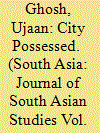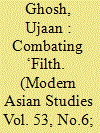| Srl | Item |
| 1 |
ID:
188403


|
|
|
|
|
| Summary/Abstract |
The mid twentieth-century Bengali ghost story has a distinct urban form. From haunting Gothic mansions, ominous bungalows and thickets of trees, the ghosts of mid twentieth-century fiction show up in the streets of Calcutta, on motorised omnibuses, in urban movie theatres and even selling cocaine in the docks of the city. In this paper, I explore why Bengali ghost stories in the twentieth century predominantly choose the city as a motif to situate their hauntings. I analyse two spectral texts from the mid twentieth century, ‘Kankal Sarathi (The Skeleton Chauffeur)’ by Hemendra Kumar Ray (1888–1963) and ‘Andhakre (In Darkness)’ by Sharadindu Bandyopadhyay (1899–1970), and juxtapose them alongside the official urban archive. Significant changes took place in Calcutta’s urban planning at the turn of the twentieth century. Committed to ‘improving’ the city, planners sought large-scale demolitions of existing buildings, which resulted in massive displacement of individuals and communities. Historians have recorded the deep disquiet these changes induced in the city’s inhabitants. What I demonstrate are the ways in which ghost stories responded to these infrastructural alterities. Spectral narratives emerged as a new literary strategy through which the city’s new journey towards infrastructural modernity was critiqued. The larger methodological question I wish to explore is whether it is possible to treat the genre of horror as an extended archive of historical inquiry.
|
|
|
|
|
|
|
|
|
|
|
|
|
|
|
|
| 2 |
ID:
168779


|
|
|
|
|
| Summary/Abstract |
This article interrogates the urbanization of Puri at the time of the cholera epidemic in the latter half of the nineteenth century. In the wake of the epidemic the colonial state took serious steps to reorder the urban landscape of the pilgrim town in general and Puri in particular. However, in Puri the narrative of infrastructural development is slightly complicated by the presence of the temple of Jagannath which acted as an alternative public body. Thus, on every occasion the colonial state had to negotiate with the temple in order to facilitate urban governance in Puri. As a result, I argue, Puri's urban landscape could only develop through interaction and negotiation between the temple and the state.
|
|
|
|
|
|
|
|
|
|
|
|
|
|
|
|